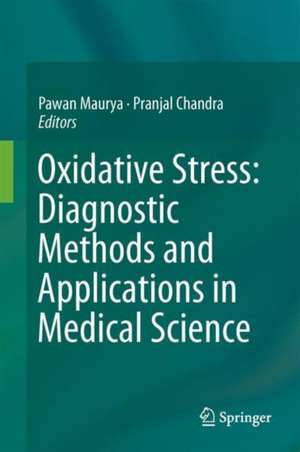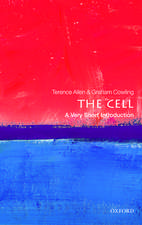Oxidative Stress: Diagnostic Methods and Applications in Medical Science
Editat de Pawan Kumar Maurya, Pranjal Chandraen Limba Engleză Hardback – 6 noi 2017
Oxidative stress is associated with diminished capacity of a biological system to overcome the overproduction of reactive oxygen species. Since oxidative stress has been suggested as a causative factor in many diseases, its prevention is vital, and there is an urgent need for oxidative stress monitoring using in vitro and in vivo models. Interdisciplinary approaches have lead to the development of various oxidative stress monitoring models for real-world clinical and biomedical applications. The development of such methods requires a broad understanding of biology, chemistry, molecular biology, immunology and microbiology. As such, the book is a valuable resource for students, researchers and clinicians interested in the fundamental as well as applied aspects of oxidative stress associated diseases.
| Toate formatele și edițiile | Preț | Express |
|---|---|---|
| Paperback (1) | 550.06 lei 38-44 zile | |
| Springer Nature Singapore – 13 dec 2018 | 550.06 lei 38-44 zile | |
| Hardback (1) | 647.40 lei 22-36 zile | |
| Springer Nature Singapore – 6 noi 2017 | 647.40 lei 22-36 zile |
Preț: 647.40 lei
Preț vechi: 761.65 lei
-15% Nou
Puncte Express: 971
Preț estimativ în valută:
123.90€ • 129.01$ • 104.71£
123.90€ • 129.01$ • 104.71£
Carte disponibilă
Livrare economică 17 februarie-03 martie
Preluare comenzi: 021 569.72.76
Specificații
ISBN-13: 9789811047107
ISBN-10: 9811047103
Pagini: 168
Ilustrații: X, 168 p. 47 illus., 21 illus. in color.
Dimensiuni: 155 x 235 mm
Greutate: 0.61 kg
Ediția:1st ed. 2017
Editura: Springer Nature Singapore
Colecția Springer
Locul publicării:Singapore, Singapore
ISBN-10: 9811047103
Pagini: 168
Ilustrații: X, 168 p. 47 illus., 21 illus. in color.
Dimensiuni: 155 x 235 mm
Greutate: 0.61 kg
Ediția:1st ed. 2017
Editura: Springer Nature Singapore
Colecția Springer
Locul publicării:Singapore, Singapore
Cuprins
Chemical Biology of Oxidative Stress and its Role in the Pathophysiology of Neuropsychiatric Disorders.- Oxidative stress: Diagnostic methods and application in medical science.- Nanomaterials in Antioxidant Research.- Gold Nanoparticle-based Methods for Detection of Oxidative Stress Biomarkers.- Hydroxamic acids as potent antioxidants and their methods of evaluation.- Oxidative stress related Micro-RNAs as diagnostic markers: A newer insight in diagnostics.- Oxidative Stress Monitoring Using in vitro Systems: Tools and Findings.- Oxidative stress mediated Human Diseases.- Potential Applications of Antioxidants from Algae in Human Health.
Notă biografică
Dr. Pawan Kumar Maurya is currently employed as Assistant Professor at Amity Institute of Biotechnology, Amity University Noida, India. He has done a Ph.D. from the University of Allahabad (A Central University), India & post-doctoral training from Universidade Federal de Sao Paulo-UNIFESP, Brazil, Taipei Medical University (TMU) and National Taiwan University (NTU), Taiwan. He is working on Biochemical diagnostics, nanomedicine, and clinical biochemistry. He has published over 48 research articles in reputed journals. He is recipient of prestigious fellowship: Science without Borders (Government of Brazil).
Dr. Pranjal Chandra is currently employed as Assistant Professor and principal investigator at Department of Biosciences and Bioengineering, Indian Institute of Technology Guwahati, Assam, India. He earned his Ph.D. from Pusan National University, South Korea and did post-doctoral training at Technion-Israel Institute of Technology, Israel. He has publishedover 50 research articles in reputed journals and 1 book (IET, United Kingdom). He is also a visiting scientist at IBST, South Korea. Pranjal's research contributions are highly interdisciplinary, spanning a wide range in nanobiotechnology, nanobiosensors, lab-on-chip systems for biomedical diagnostics, and nanomedicine. His work has been highlighted in the World news of Royal Society of Chemistry, Cambridge as "A new system for cancer detection” and also featured as a key scientific article in the Global Medical Discovery news Canada. He is recipient of many prestigious awards and fellowships such as; Ramanujan fellowship (Government of India), BK -21 and NRF fellowship of South Korea, Technion post-doctoral fellowship, Israel, University of Montreal Post-doc fellowship, Canada, NMS Young scientist Award etc. He is also editorial board member of a dozen international journals including; World journal of methodology, USA; Frontiers of Biosciences, USA; Journal of Biosensors and Bioelectronics, USA etc.
Dr. Pranjal Chandra is currently employed as Assistant Professor and principal investigator at Department of Biosciences and Bioengineering, Indian Institute of Technology Guwahati, Assam, India. He earned his Ph.D. from Pusan National University, South Korea and did post-doctoral training at Technion-Israel Institute of Technology, Israel. He has publishedover 50 research articles in reputed journals and 1 book (IET, United Kingdom). He is also a visiting scientist at IBST, South Korea. Pranjal's research contributions are highly interdisciplinary, spanning a wide range in nanobiotechnology, nanobiosensors, lab-on-chip systems for biomedical diagnostics, and nanomedicine. His work has been highlighted in the World news of Royal Society of Chemistry, Cambridge as "A new system for cancer detection” and also featured as a key scientific article in the Global Medical Discovery news Canada. He is recipient of many prestigious awards and fellowships such as; Ramanujan fellowship (Government of India), BK -21 and NRF fellowship of South Korea, Technion post-doctoral fellowship, Israel, University of Montreal Post-doc fellowship, Canada, NMS Young scientist Award etc. He is also editorial board member of a dozen international journals including; World journal of methodology, USA; Frontiers of Biosciences, USA; Journal of Biosensors and Bioelectronics, USA etc.
Textul de pe ultima copertă
This book discusses the importance of oxidative stress, related biomarkers, and its diagnostic methods including bio-analytical and advanced detection systems.
Oxidative stress is associated with diminished capacity of a biological system to overcome the overproduction of reactive oxygen species. Since oxidative stress has been suggested as a causative factor in many diseases, its prevention is vital, and there is an urgent need for oxidative stress monitoring using in vitro and in vivo models. Interdisciplinary approaches have lead to the development of various oxidative stress monitoring models for real-world clinical and biomedical applications. The development of such methods requires a broad understanding of biology, chemistry, molecular biology, immunology and microbiology. As such, the book is a valuable resource for students, researchers and clinicians interested in the fundamental as well as applied aspects of oxidative stress associated diseases.
Oxidative stress is associated with diminished capacity of a biological system to overcome the overproduction of reactive oxygen species. Since oxidative stress has been suggested as a causative factor in many diseases, its prevention is vital, and there is an urgent need for oxidative stress monitoring using in vitro and in vivo models. Interdisciplinary approaches have lead to the development of various oxidative stress monitoring models for real-world clinical and biomedical applications. The development of such methods requires a broad understanding of biology, chemistry, molecular biology, immunology and microbiology. As such, the book is a valuable resource for students, researchers and clinicians interested in the fundamental as well as applied aspects of oxidative stress associated diseases.
Caracteristici
This book covers the basics of oxidative stress monitoring in the laboratory as well as it's commercial aspects The novel design aspect of diagnostics keeping the clinical viability of oxidative stress monitoring is highlighted in this book It provides new insight into how oxidative stress damages biomolecules and plays role in disease progression It also talks about most recent diagnostic methods such as nanosensors









